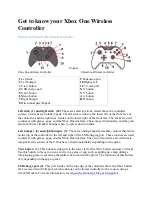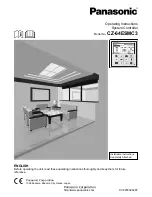
Page 2 of 6
HP400-IOM Rev. 0 7/20
THIS INFORMATION IS SUBJECT TO THE CONTROLS OF THE EXPORT ADMINISTRATION REGULATIONS (EAR). THIS INFORMATION SHALL NOT BE PROVIDED TO
NON-US PERSONS OR TRANSFERRED BY ANY MEANS TO ANY LOCATION OUTSIDE THE UNITED STATES CONTRARY TO THE REQUIREMENTS OF THE EAR.
set pressure. In equilibrium, the force exerted by the range
spring is balanced by the outlet pressure.
An unbalance between the outlet pressure and the set
pressure causes a corresponding reaction on the piston sensor
and valve. If the outlet pressure rises above the set pressure,
the piston sensor will lift allowing the valve to seat. If the outlet
pressure falls below the set pressure, the range spring will
push the piston down and unseat the valve. At equilibrium, the
valve plug assumes a position which supplies the required flow
while maintaining the outlet pressure at the set pressure.
(See Figure 1 on page 4 for labeled section view)
Setting Limit on Maximum Outlet (Control) Pressure
The handwheel on the HP400 Regulator can be adjusted to
limit the maximum outlet pressure attainable to any value up to
100% of the rated outlet pressure range. To set this limit,
connect the regulator to a pressure source and a gauge to
indicate the regulator outlet pressure. Apply an inlet pressure
to the regulator equal to the maximum inlet pressure expected
in service. Remove the hole plug from the handwheel and
loosen the jam nut using a 9/16” socket. Using a screwdriver,
turn the adjusting screw clockwise until the indicated outlet
pressure is at the pressure at which the limit is desired. Spin
the handwheel clockwise until it stops against the top of the
bonnet. Then turn the handwheel back about 1/8 of a turn
counterclockwise and hold it in this position. While doing so,
tighten the jam nut against the handwheel with 70 – 120 in.lbs
of torque. Turn the handwheel counterclockwise until it is no
longer seated against the top of the bonnet. Check by
adjusting the handwheel clockwise to insure that it stops
against the bonnet when the output pressure reaches the
desired maximum pressure.
SCHEDULED MAINTENANCE
All regulators require scheduled maintenance to remove
deposits left by the media and to replace parts worn or
damaged as a result of use. Annual maintenance is
recommended when the regulator is used under normal
conditions. More frequent maintenance may be required due to
the condition, cleanliness and/or corrosiveness of the media.
TOOLS REQUIRED
7/16” Wide blade screwdriver bit having 1/8” wide x 3/8” deep
notch (seat gland)
9/16” Socket (jam nut within standard hand knob)
9/16” Open end wrench (jam nut on wrench knob or “T”
handle)
1-7/8” Socket or wrench (bonnet)
Internal snap ring pliers (retaining rind in sensor bore)
Pliers (to remove sensor from bore)
Other tools and maintenance aids include a vise, tweezers,
clean lint free cloth, swabs, and a torque wrench.
CAUTION: MAINTENANCE
It is recommended that maintenance be performed by a person
experienced in the operation and repair of high pressure
regulators.
Maintenance of this unit is best performed by gripping a
protruding end of a pipe fitting installed into the regulator body.
WARNING:
Bleed System Pressure Prior to Removing
Regulator for Servicing
.
MAINTENANCE PROCEDURE
1. Adjust the handwheel to the full counterclockwise position
until the handwheel, hole plug, jam nut, and adjusting screw
are fully disengaged.
2. Using a 1-7/8” wrench, loosen and remove the bonnet.
3. Remove the spring button, range spring, and the range
spring backup plate.
4. With internal snap ring pliers, remove the retaining ring.
5. Using pliers, grip and remove the piston sensor for service
to the backup ring and O-ring.
6. The main valve assembly can be disassembled by using a
modified screwdriver bit to turn the seat gland
counterclockwise until it is free from the regulator body. The
main valve plug, main valve sear, and the plug spring can be
lifted from the body.
7. Remove the main valve seat from the seat gland.
(See Figure 2 on page 4 for exploded view)
THE REGULATOR IS RE-ASSEMBLED IN THE
REVERSE ORDER OF DISASSEMBLY, OBERSVING
THE FOLLOWING PRECAUTIONS:
1. Inspect all component parts and replace those worn or
damaged with ITT Conoflow replacement parts.
2. All component parts should be cleaned to the cleanliness
level required for safe operation with the media used. All parts
in the flow stream must be free of particles which could prevent
proper seating of the main valve.
3. Place the plug spring in the body bore (See Figure 3 for
section view) Place the main valve plug into the body.
Lubricate the threads of the seat gland with Krytox grease and
press the main valve seat into the seat gland. For the standard
Kel-F (PCTFE) seat, install the seat into the seat gland with the
identification face groove facing out of the seat gland (ignore
this orientation requirement if the valve seat is Vespel).
4. Carefully guide the seat gland and the main valve seat
assembly into the body, as to not scratch or score the piston
sensor bore. Once in place screw the seat gland into the body.
Make sure the seat is correctly positioned in the seat gland
before tightening the seat gland.
5. Lubricate the O-ring(s) and the backup ring with Krytox.
Lubricate the groove on the piston sensor with Krytox. Install
the O-ring in the groove. Install the backup ring in the groove
on the side which is closest to the small diameter end of the
sensor. If the standard scarf cut Teflon backup ring is used, be
careful not to bend the backup ring too much. If an optional
Buna-N backup ring is used, install the backup ring with the
curved side towards the O-ring.
6. Lightly lubricate the piston sensor bore of the body with
Krytox and slide the piston sensor into the body with the small
























